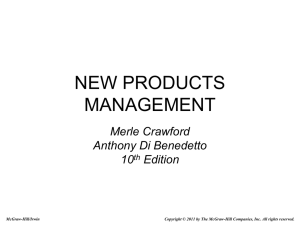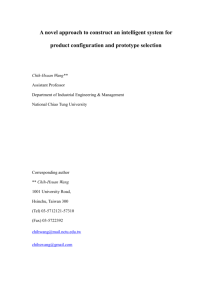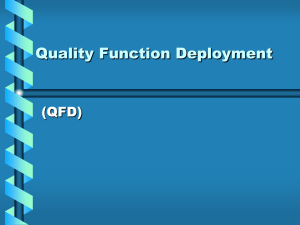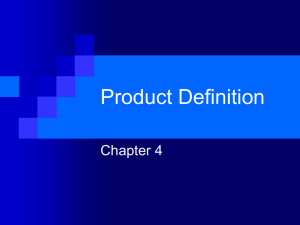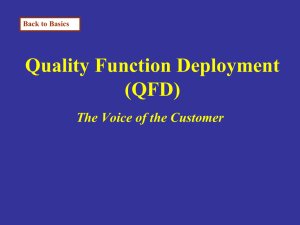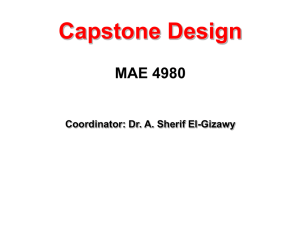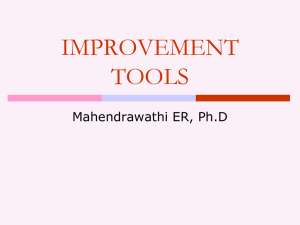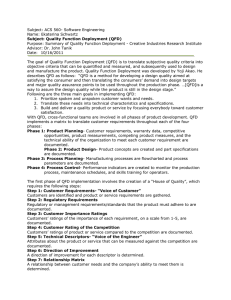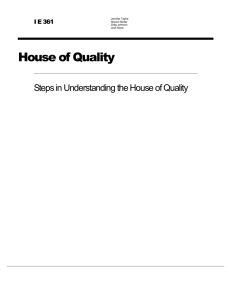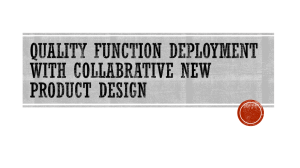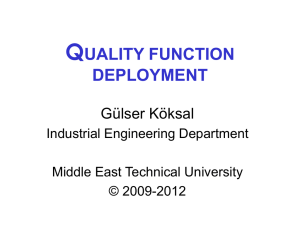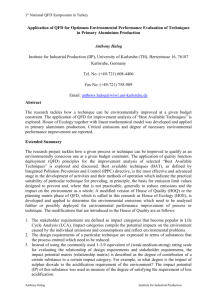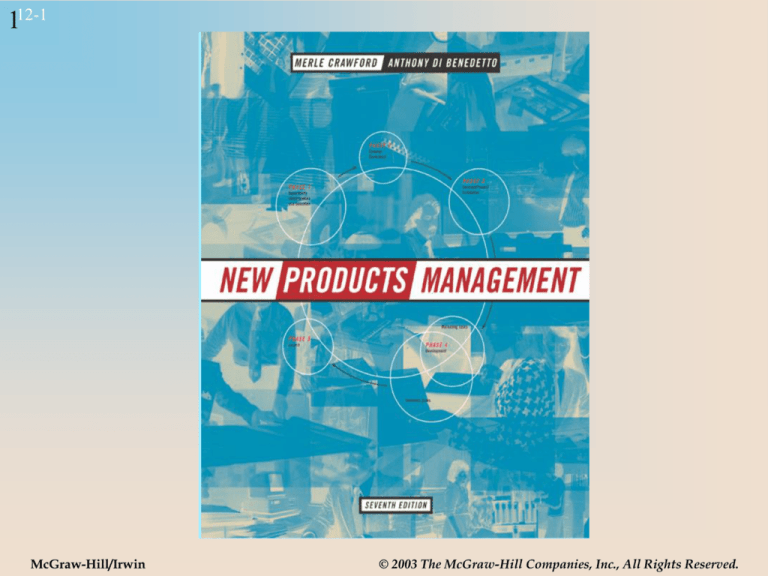
112-1
McGraw-Hill/Irwin
© 2003 The McGraw-Hill Companies, Inc., All Rights Reserved.
212-2
CHAPTER TWELVE
PRODUCT PROTOCOL
312-3
The Integrating and Focusing Role of
Protocol
Figure 12.1
412-4
Why Have A Protocol?
• Also known as product requirements, product
definition, etc.
• Doesn’t it seem obvious and simple?
• Actually is one of the top success factors
distinguishing winning from losing projects.
• Maybe because it involves more than technical
aspects.
• POLITICS!!!
512-5
Purposes of Protocol
• To determine what marketing and R&D need to do their work.
– More than a simple concept statement, yet less than we will
have when the first prototype is available
– Identify key deliverables
• To communicate essentials to all players and integrate their
actions, assuring outcomes that are consistent with what was
concept tested, screened and financially analyzed.
• To set boundaries on development process and cut cycle time
by clarifying measurable product and marketing requirements.
• To permit the development process to be managed (i.e., what
needs to be done, when, why, how, and by whom—and
knowing whether we have met the objectives/requirements).
612-6
Contents of a Product Protocol
•
•
•
•
•
•
•
•
•
•
•
•
Target market
Product positioning
Product attributes (benefits)
Competitive comparison
Augmentation dimensions
Timing
Marketing requirements
Financial requirements
Production requirements
Regulatory requirements
Corporate strategy requirements
Potholes
712-7
Narrow Version of Protocol: End-User “I
Want” List
This is the “I Want” list for a new lawn leaf blower /vacuum.
These are benefits -- how they are achieved is determined
during development.
• Manufacturer stands behind product -- two year full warranty.
• Electrically and mechanically safe. Good value and lasts a long time -top quality component parts, state-of-the-art manufacturing.
• Makes yard clean-up easier -- most powerful blower you can buy.
• Converts from blower to vacuum without tools.
• Electrical cord does not come loose.
• Can be used with existing extension cord.
• Easy to maneuver.
• Clog-free vacuuming.
• Tubes go together and stay together.
812-8
A Sample Protocol: Trash Disposal System
Figure 12-2
• Must automate trash disposal at factory cost not to exceed $800.
• Clean, ventilated, odor-free, no chance of combustion.
• Must be safe enough to be operated by children; outside storage
safeguards against children and animals.
• Size must be small enough to work as kitchen appliance, to provide
easy access and eliminate need for double handling of trash.
• Simple installation
• Decor adaptable to different user tastes.
• If design requires opening of exterior walls, structural integrity and
insulation against elements must be maintained.
• User-friendly, automatic operation, easy to maintain by technical
servicepeople.
912-9
Quality Function Deployment (QFD)
• A technique designed to insure that customer
needs are focused on throughout the new
product project.
• First step is the House of Quality (HOQ):
gathers desired attributes from customers and
translates them to engineering characteristics.
• Requires inputs from marketing and technical
personnel; encourages communication and
cooperation across the functional areas.
12-10
10
QFD and Its House of Quality
Figure 12.3
12-11
11
Benefits in QFD Example
•
•
•
•
Compatibility
Print quality
Ease of use
Productivity
12-12
12
Technologies in QFD Example
•
•
•
•
•
•
•
Postscript compatible
Resolution
Edge sharpness
Duplex printing
Hours training required
Speed (text)
Speed (graphics)
12-13
13
Tradeoffs in QFD Example
• Improving resolution slows down text
printing and really slows down graphics
printing.
• Increasing edge sharpness slows down both
text and graphics printing.
• Duplex printing speeds up text and graphics
printing.
• Postscript compatibility improves resolution
and edge sharpness.
12-14
14
Moving to Later Stages of QFD
Figure 12.4
House of Quality:
Engineering Characteristics
Customer Attributes
Converted to:
Parts Deployment:
Parts Characteristics
Engineering Characteristics
Converted to:
Process Planning:
Parts Characteristics
Process Operations
Converted to:
Production Planning:
Process Operations
Production Requirements
Converted to:
Source: Adapted from John R. Hauser and Don Clausing, “The House of Quality,” Harvard Business
Review, May-June, 1988.
12-15
15
QFD Realities
• Substantial cost and time commitment.
• Only mixed results in some applications.
• Requires top management support and
commitment.
• Must be viewed internally as an investment.
• Requires good functional integration.
• May work better if the team members have a
successful track record of working together
before—and if they use QFD consistently.

